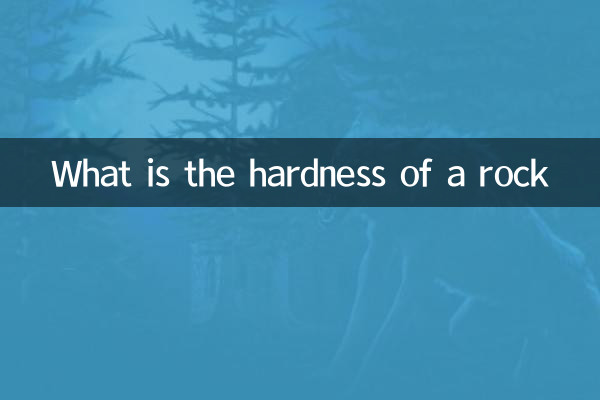What is the hardness of a rock
The hardness of a rock is an important physical property in geology, which describes the ability of a rock to resist external forces such as scratching, pressing or cutting. The measurement of hardness not only helps the classification of rocks, but also has practical application value in engineering, construction and mining fields. This article will introduce in detail the definition, measurement methods and their application in practice.
1. Definition of rock hardness

The hardness of a rock usually refers to its ability to resist external damage, specifically manifested as its strength to resist scratches, pressing or cutting. Hardness is closely related to the mineral composition, structure and structure of rocks. For example, quartz is a high-hardness mineral, so rocks containing quartz, such as granite, are usually harder.
2. Methods for measuring rock hardness
At present, there are mainly the following methods to measure rock hardness:
| Measurement method | principle | Applicable rock types |
|---|---|---|
| Mohs hardness | Comparison of hardness by scratching between minerals | Single mineral rock or mineral aggregate |
| Shore hardness | Measure hardness by rebound height | Homogenous rocks |
| Rockwell hardness | Measure hardness by pressing depth | Dense rocks |
| Vickers hardness | Calculate hardness by diagonal length of indentation | Fine-grained rock |
3. Comparison of hardness of common rocks
The hardness of different rocks varies greatly. The following are the Mohs hardness ranges of several common rocks:
| Rock Name | Mohs hardness range | Main mineral components |
|---|---|---|
| granite | 6-7 | Quartz, feldspar, mica |
| Dali Rock | 3-4 | Calcite, dolomite |
| sandstone | 6-7 | Quartz, feldstone |
| shale | 2-3 | Clay minerals |
4. Practical application of rock hardness
Rock hardness has important applications in many fields:
1.Construction Engineering: High hardness rocks (such as granite) are often used in exterior walls and floors that require wear resistance.
2.Mining Development: Hardness data helps select mining tools and crushing equipment.
3.Geological Exploration: Through hardness analysis, the formation environment and geological history of rocks can be inferred.
4.Cultural Relics Protection: Understanding the hardness of rocks will help formulate protection plans for stone cultural relics.
5. Factors affecting rock hardness
Rock hardness is affected by a variety of factors, mainly including:
1.Mineral ingredients: The higher the content of minerals such as quartz, the greater the hardness of the rock.
2.Structural structure: Fine-grained rocks are usually harder than coarse-grained structures.
3.Weathering degree: Weathering will significantly reduce the hardness of the rock.
4.Temperature pressure: Rocks formed in high temperature and high pressure environments usually have higher hardness.
6. Latest progress in rock hardness research
In recent years, with the advancement of testing technology, new breakthroughs have been made in the research on rock hardness:
1. The application of nano-indentation technology makes it possible to measure rock hardness on microscopic scales.
2. Computer simulation technology can predict the hardness of rocks of different mineral combinations.
3. The development of a new portable hardness testing instrument has improved the efficiency of field work.
4. The study on the relationship between rock hardness and seismic wave velocity provides new ideas for earthquake prediction.
Conclusion
Rock hardness is a complex but important physical property that reflects the formation environment and compositional characteristics of the rock. By scientifically measuring and analyzing rock hardness, we can not only better understand the evolutionary history of the earth, but also provide important reference for engineering practice. With the continuous development of testing technology, the research on rock hardness will be more accurate and in-depth.

check the details

check the details